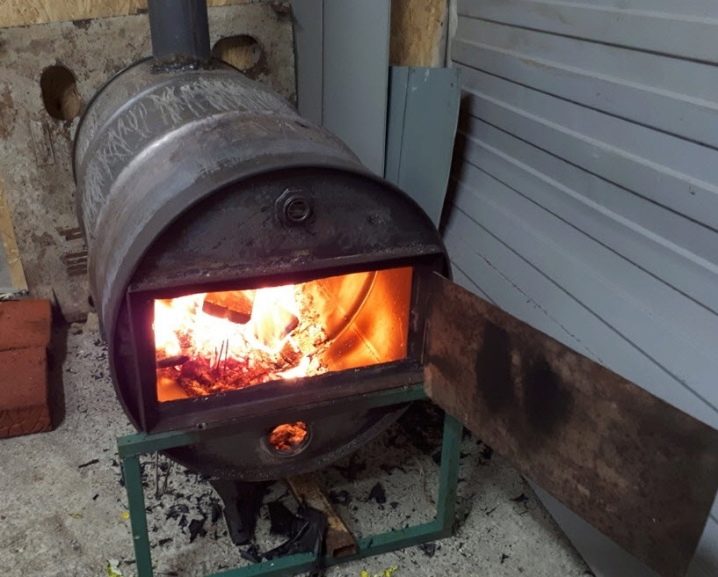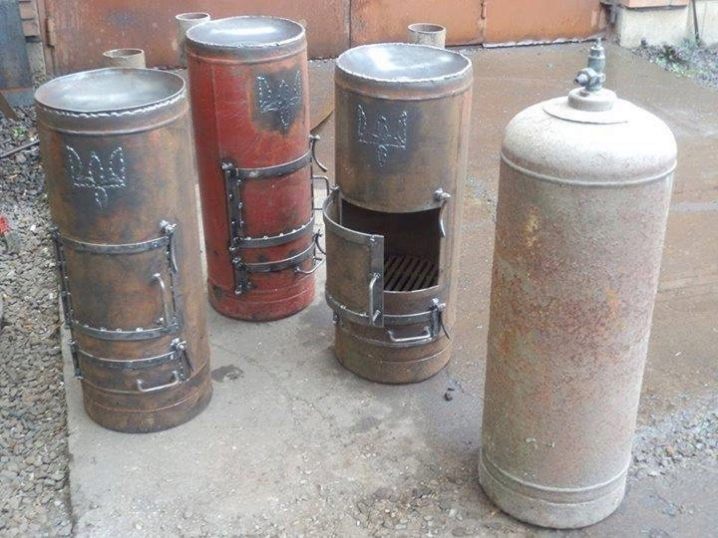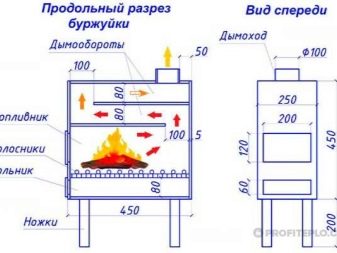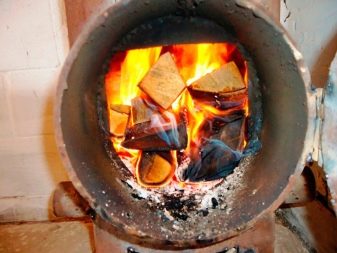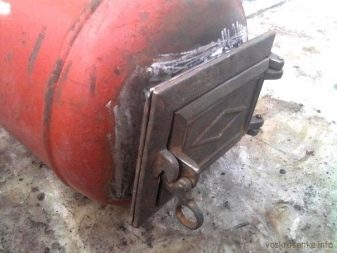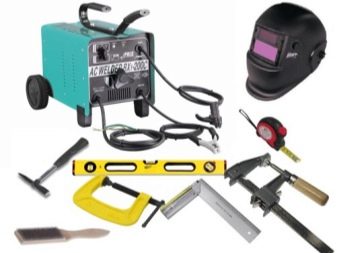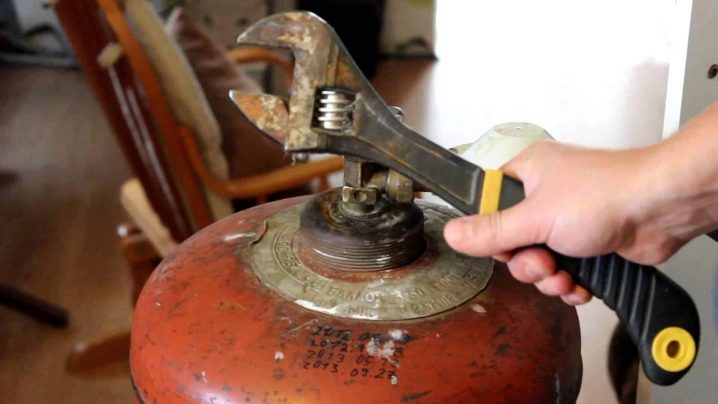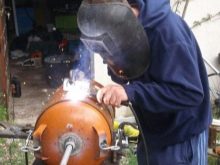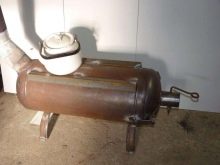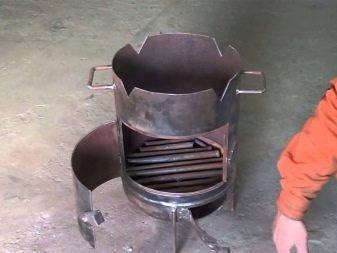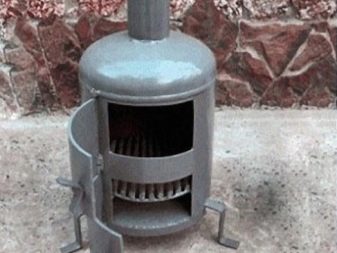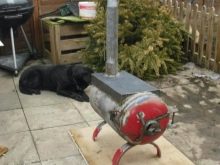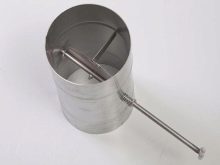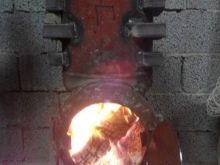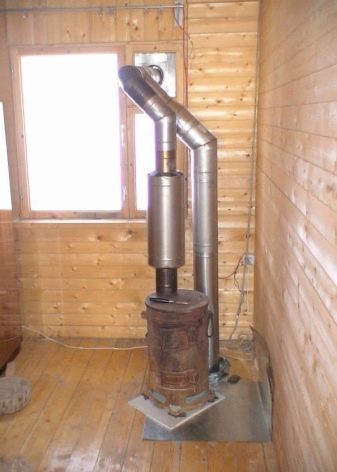How to make a furnace for the garage of the gas cylinder?

Everyone knows from experience how uncomfortable in the winter in a garage without heating. In addition to thermal insulation of the walls, roof, floor and ceiling, the classic option for obtaining heat in the garage is a stove.
Usually this is a very common unit of the "stove" type, welded from pieces of pipes, or used cases of gas cylinders.
The furnace of the gas cylinder: the pros and cons
There are many other options: welded from sheet iron, folded from bricks, and so on.But today we are interested in the most common and functional option - the furnace, converted from a gas cylinder, as the price tag of the finished cast-iron or steel plate in the store is not for everyone.
Independent production of "potbelly stove" from a gas cylinder - the most economical and effective means of heating the garage.
Fuel options for the "burzhuek" can be many: coal, mining, combustible mixture, but mostly they are natural materials - wood.
Calculation of parameters: drawings and recommendations
Start with the selection of the source material. A 50-liter gas bottle is ideal.
Its dimensions: 300 mm in diameter, 850 mm in height with 4 mm metal wall.
Such cylinders are commonly used in various fields, from fuel for cooking stoves to industrial applications.
The main parameters and features of the manufacture of the stove:
- The chimney is usually made of a pipe with a section of 100-125 mm with a wall of 3-4 mm;
- placed it vertically, possibly with a slight deviation, in 25-350;
- the furnace and the ashpit are equipped with doors that must be locked to improve heat transfer during fuel combustion and for fire-fighting purposes; in addition, the doors are used to regulate the air supply;
- It is important that the firebox should have sufficient depth for firewood of a convenient size;
- grates are needed for laying fuel and separating ash and coal in the process of firing;
- it is better to weld them from the most durable and heat-resistant material, for example, from reinforcing bars 12-15 mm thick;
- their length should correspond to the inner diameter of the cylinder body; this grille usually has a mesh or gap with a pitch of 10–15 mm;
- so that your “potbelly stove” can be heated and properly heated on the wood, it is built on the principle of a conventional wood-burning stove.
DIY building
Consider the approximate scheme.
- The firebox and ashpit are separated by a refractory grate.
- Firewood is laid on it and set on fire. As it burns, soot and coal are poured into the ash pan.
- The blower is an important element of the furnace. For the best combustion of wood, a firebox requires a constant supply of air, for which holes are made.
- An alternative way to ensure the process of burning with oxygen is required from time to time to open the door of the furnace.
- Combustion products are removed through the chimney. If it is laid incorrectly, you can achieve the opposite effect - instead of smoke, a significant part of the heat will disappear through the pipe, and smoke will be generated indoors.Consequently, there will be unnecessarily spent a lot of firewood, which will lead to low efficiency.
How does she work?
The principle of our stove:
- air is blown into the firebox through the ash chamber;
- fuel burns in whole or in part;
- through the chimney, the products of combustion pull into the atmosphere with natural friction;
- It is possible to regulate the process of continuous burning with the required heat transfer by ensuring continuous burning;
- the process is adjusted by opening / closing the door of the blower or view.
Materials
To make a stove, prepare the following materials:
- metal sheet for ash pan and hob, if the stove is located horizontally;
- chimney pipe (preferably with two bends);
- materials for fixing grates and supports;
- oven doors.
Instruments
For work you will need:
- welding machine;
- grinding machine;
- welding electrodes;
- hammer;
- tape measure, measuring tape;
- chisel;
- pliers;
- (electric drill;
- brush with metal bristles for stripping;
- chalk pencil.
Preparatory work
Before proceeding directly to the manufacture of the stove, you need to prepare a cylinder for work.
- We get rid of the contents of the cylinder by opening the valve completely.
- When the gas ceases to produce a hiss, in addition, observing all safety measures, it is possible to slightly warm up the cylinder.
- Mercaptan fragrance (odorant) - has not the most pleasant smell, so you need to get rid of it. One way is to completely fill the container with an acid-containing liquid (bleach, cleaning agents, and the like) for a while.
- Clean the inner surface of the container with soda solution of NaCl 10%.
Making the stove from the gas cylinder do it yourself
It is necessary to make the choice of the orientation of the position of the stove (horizontal or vertical).
The difference between these options in the purpose of use.
- Horizontally located stove is usually more used for cooking.
- Upright stove - for heating due to greater traction and space saving.
For the second reason, this option is more often used in capital garages.
Making a horizontal version:
- the upper part, where the valve is located, is cut off from the cylinder to install the door (the photo shows another option, where instead of cutting off the upper part, a ready-made cast-iron door is used);
- openings for the grate are drilled in the wall of the cylinder, or fasten fasteners inside to arrange the removable grate;
- supports / legs / skids and the like are attached below;
- if the grate is drilled in the cylinder body - an ashpit-tray made of sheet metal is attached to the bottom;
- in the wall of the cylinder as close as possible to the bottom of the adapter is welded to the chimney;
- chimney pipe must contain the so-called "knee".
Production of the vertical version:
- cut off the valve, and in its place welded pipe for the chimney 10-15 cm;
- 5-7 cm above the bottom for a blower making a hole;
- 5-7 cm more recede from it and cut out an aperture for a door;
- inside the tank, in the opening between them, the grate is inserted, or the fixings for the removable grill are welded;
- install door with latches and supports / pozhki / runners.
Features of operation, cleaning and repair
We give a number of useful tips for proper and economical operation of the stove.
- The stove is set at 20-30 cm from the surface on which it stands. This is the optimum clearance for space heating.
- In the chimney, it is recommended to install a ceiling gate (view) to save wood by reducing / increasing natural draft.
- You can create a variant of the radiator by welding on metal strips / plates to increase the heating area of the walls of the stove at a distance of 5-7 mm.
- It is not necessary to paint the stove, but if the aesthetic appearance is important - the paint should be used only heat-resistant.
- The stove must necessarily be under a concrete / brick / metal support for fire safety.
- It is advisable to clean the chimney 1-2 times a year before and after the heating season. To reduce heat loss, the chimney is sometimes insulated with non-combustible materials.
- All joints of the chimney should be made as tight as possible, at least - they should not allow harmful combustion products and smoke inside the garage.
- Prefab chimney - the best solution. The beginning of the assembly should be carried out from its outer part, and not from the stove. In this case, its dismantling during maintenance, cleaning or repair will be more comfortable.
- In the garage of brick or concrete, the shortest distance to the wall is not defined. But in any case, everything that is not fireproof should be no less than half a meter from the furnace body.
- If the interior trim of the floor, walls or ceiling of the garage is made of combustible materials, the floor is necessarily covered with a sheet of non-combustible material.It should protrude from the furnace to 700-800 mm, adjacent walls are covered with non-combustible substance to a height exceeding the size of the stove for at least half a meter.
The following video clearly shows you how to make the most convenient and functional version of the gas stove from the gas cylinder.
